University Economics Assignment: Microeconomic Principles Analysis
VerifiedAdded on 2021/04/21
|6
|1183
|38
Homework Assignment
AI Summary
This economics assignment solution delves into fundamental microeconomic principles. It begins by exploring the concept of rational decision-making, emphasizing how individuals make choices to maximize benefits, and how economic incentives influence these choices. The solution then examines income elasticity of demand, differentiating between normal, luxury, and inferior goods, and illustrating how changes in income affect consumer demand for various products. The assignment provides definitions and examples for each concept, supported by academic references, making it a comprehensive resource for understanding these core economic principles. The document is a valuable resource for students seeking to grasp microeconomic theories and their practical applications.
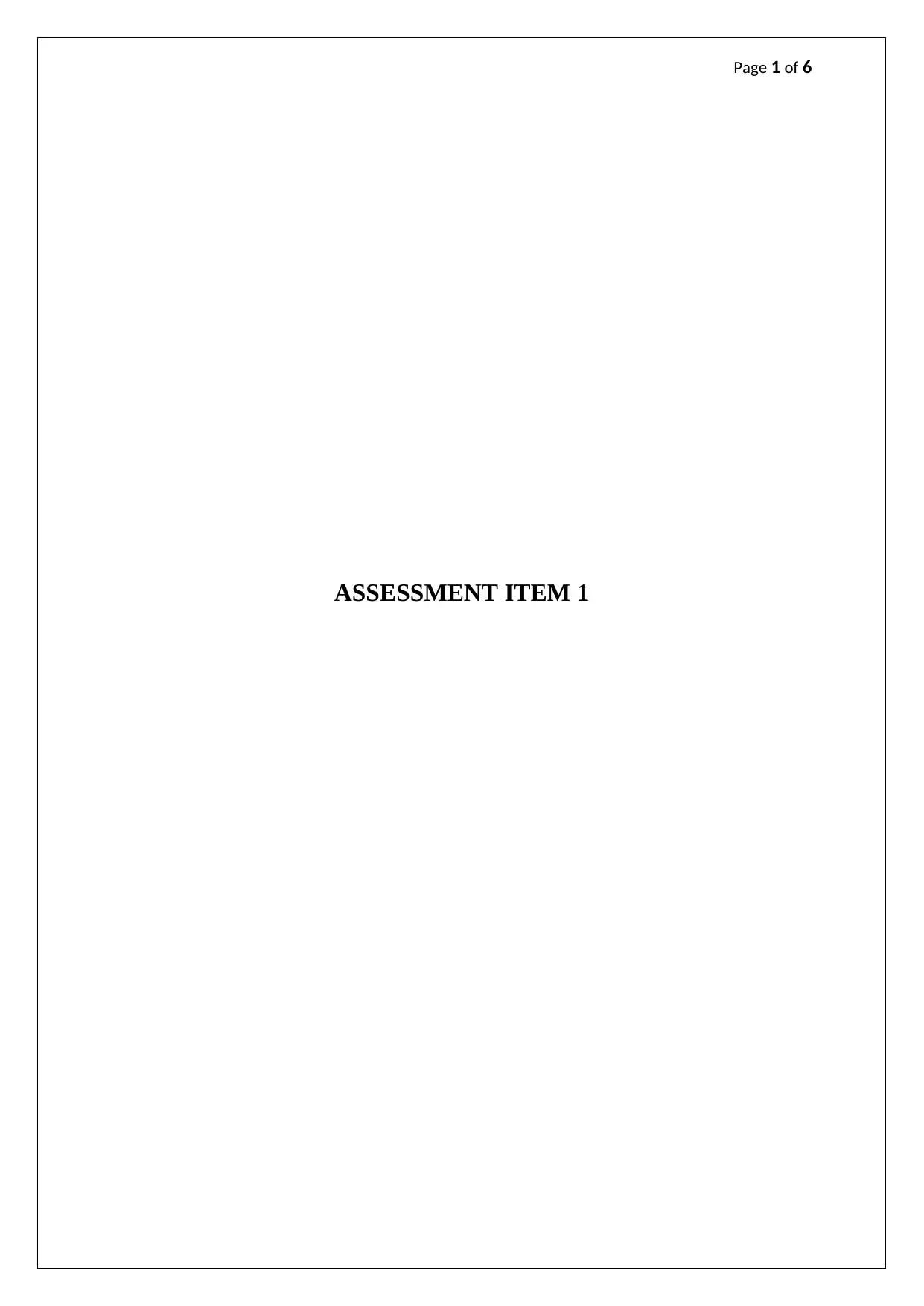
Page 1 of 6
ASSESSMENT ITEM 1
ASSESSMENT ITEM 1
Paraphrase This Document
Need a fresh take? Get an instant paraphrase of this document with our AI Paraphraser
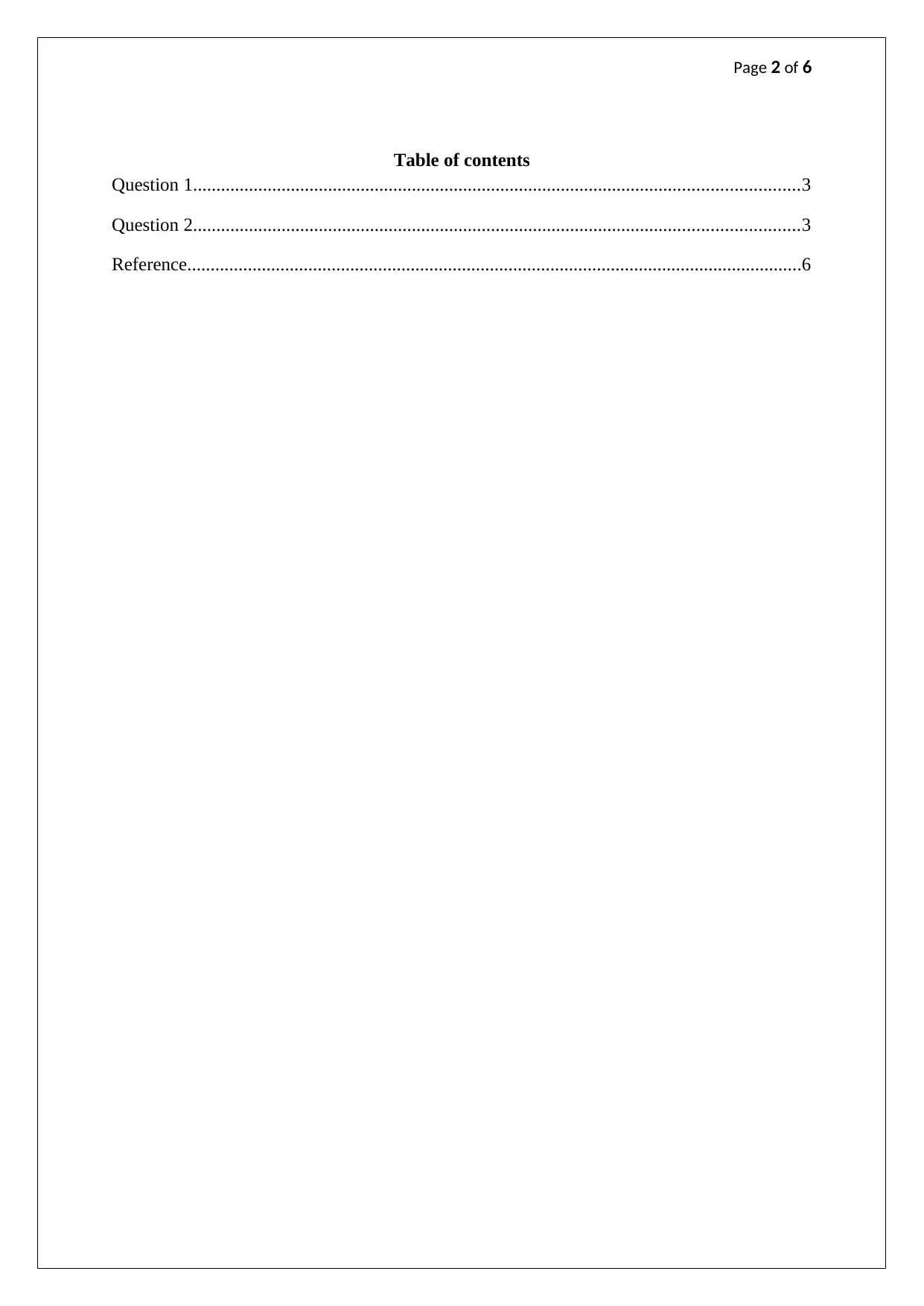
Page 2 of 6
Table of contents
Question 1..................................................................................................................................3
Question 2..................................................................................................................................3
Reference....................................................................................................................................6
Table of contents
Question 1..................................................................................................................................3
Question 2..................................................................................................................................3
Reference....................................................................................................................................6
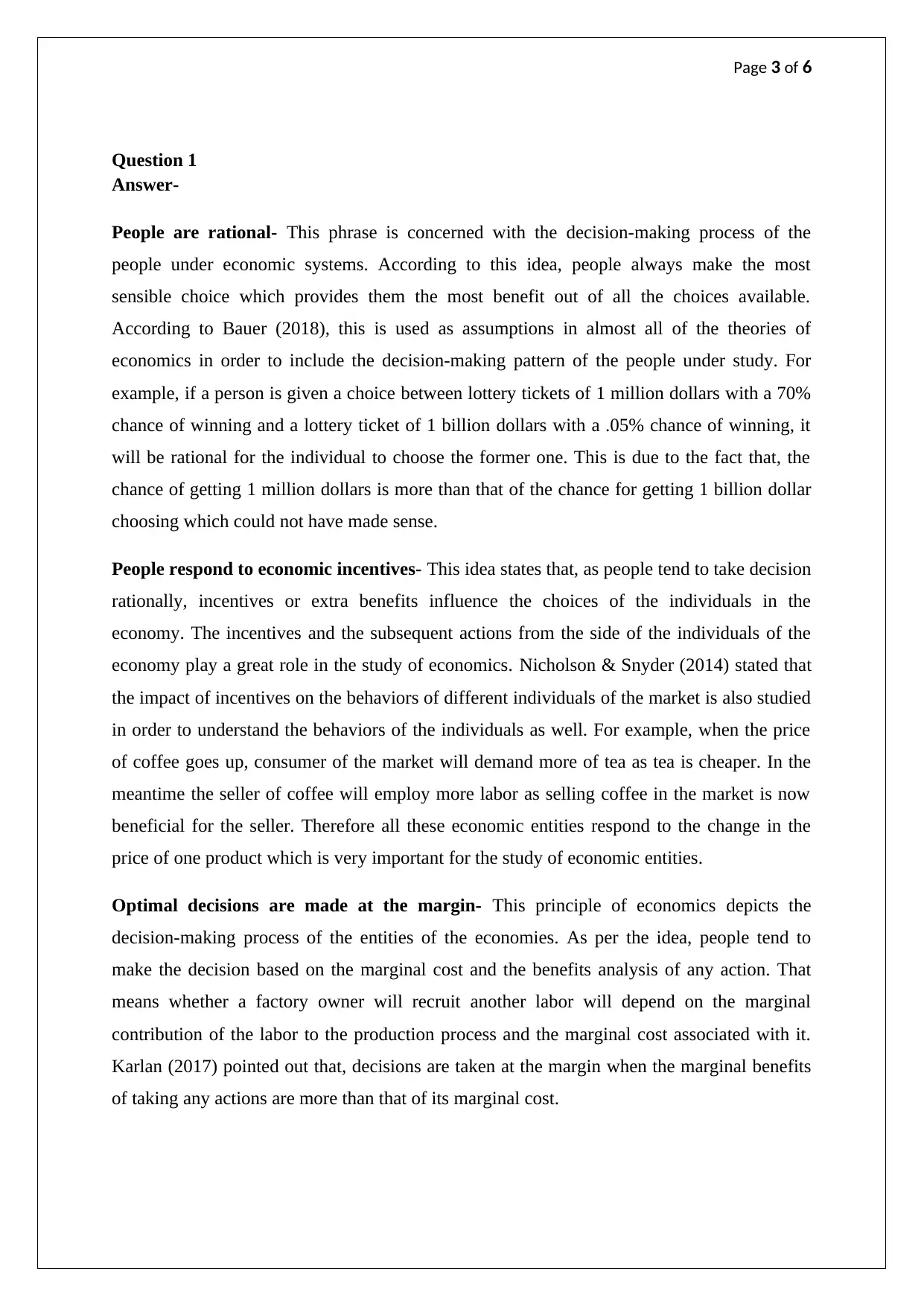
Page 3 of 6
Question 1
Answer-
People are rational- This phrase is concerned with the decision-making process of the
people under economic systems. According to this idea, people always make the most
sensible choice which provides them the most benefit out of all the choices available.
According to Bauer (2018), this is used as assumptions in almost all of the theories of
economics in order to include the decision-making pattern of the people under study. For
example, if a person is given a choice between lottery tickets of 1 million dollars with a 70%
chance of winning and a lottery ticket of 1 billion dollars with a .05% chance of winning, it
will be rational for the individual to choose the former one. This is due to the fact that, the
chance of getting 1 million dollars is more than that of the chance for getting 1 billion dollar
choosing which could not have made sense.
People respond to economic incentives- This idea states that, as people tend to take decision
rationally, incentives or extra benefits influence the choices of the individuals in the
economy. The incentives and the subsequent actions from the side of the individuals of the
economy play a great role in the study of economics. Nicholson & Snyder (2014) stated that
the impact of incentives on the behaviors of different individuals of the market is also studied
in order to understand the behaviors of the individuals as well. For example, when the price
of coffee goes up, consumer of the market will demand more of tea as tea is cheaper. In the
meantime the seller of coffee will employ more labor as selling coffee in the market is now
beneficial for the seller. Therefore all these economic entities respond to the change in the
price of one product which is very important for the study of economic entities.
Optimal decisions are made at the margin- This principle of economics depicts the
decision-making process of the entities of the economies. As per the idea, people tend to
make the decision based on the marginal cost and the benefits analysis of any action. That
means whether a factory owner will recruit another labor will depend on the marginal
contribution of the labor to the production process and the marginal cost associated with it.
Karlan (2017) pointed out that, decisions are taken at the margin when the marginal benefits
of taking any actions are more than that of its marginal cost.
Question 1
Answer-
People are rational- This phrase is concerned with the decision-making process of the
people under economic systems. According to this idea, people always make the most
sensible choice which provides them the most benefit out of all the choices available.
According to Bauer (2018), this is used as assumptions in almost all of the theories of
economics in order to include the decision-making pattern of the people under study. For
example, if a person is given a choice between lottery tickets of 1 million dollars with a 70%
chance of winning and a lottery ticket of 1 billion dollars with a .05% chance of winning, it
will be rational for the individual to choose the former one. This is due to the fact that, the
chance of getting 1 million dollars is more than that of the chance for getting 1 billion dollar
choosing which could not have made sense.
People respond to economic incentives- This idea states that, as people tend to take decision
rationally, incentives or extra benefits influence the choices of the individuals in the
economy. The incentives and the subsequent actions from the side of the individuals of the
economy play a great role in the study of economics. Nicholson & Snyder (2014) stated that
the impact of incentives on the behaviors of different individuals of the market is also studied
in order to understand the behaviors of the individuals as well. For example, when the price
of coffee goes up, consumer of the market will demand more of tea as tea is cheaper. In the
meantime the seller of coffee will employ more labor as selling coffee in the market is now
beneficial for the seller. Therefore all these economic entities respond to the change in the
price of one product which is very important for the study of economic entities.
Optimal decisions are made at the margin- This principle of economics depicts the
decision-making process of the entities of the economies. As per the idea, people tend to
make the decision based on the marginal cost and the benefits analysis of any action. That
means whether a factory owner will recruit another labor will depend on the marginal
contribution of the labor to the production process and the marginal cost associated with it.
Karlan (2017) pointed out that, decisions are taken at the margin when the marginal benefits
of taking any actions are more than that of its marginal cost.
⊘ This is a preview!⊘
Do you want full access?
Subscribe today to unlock all pages.

Trusted by 1+ million students worldwide
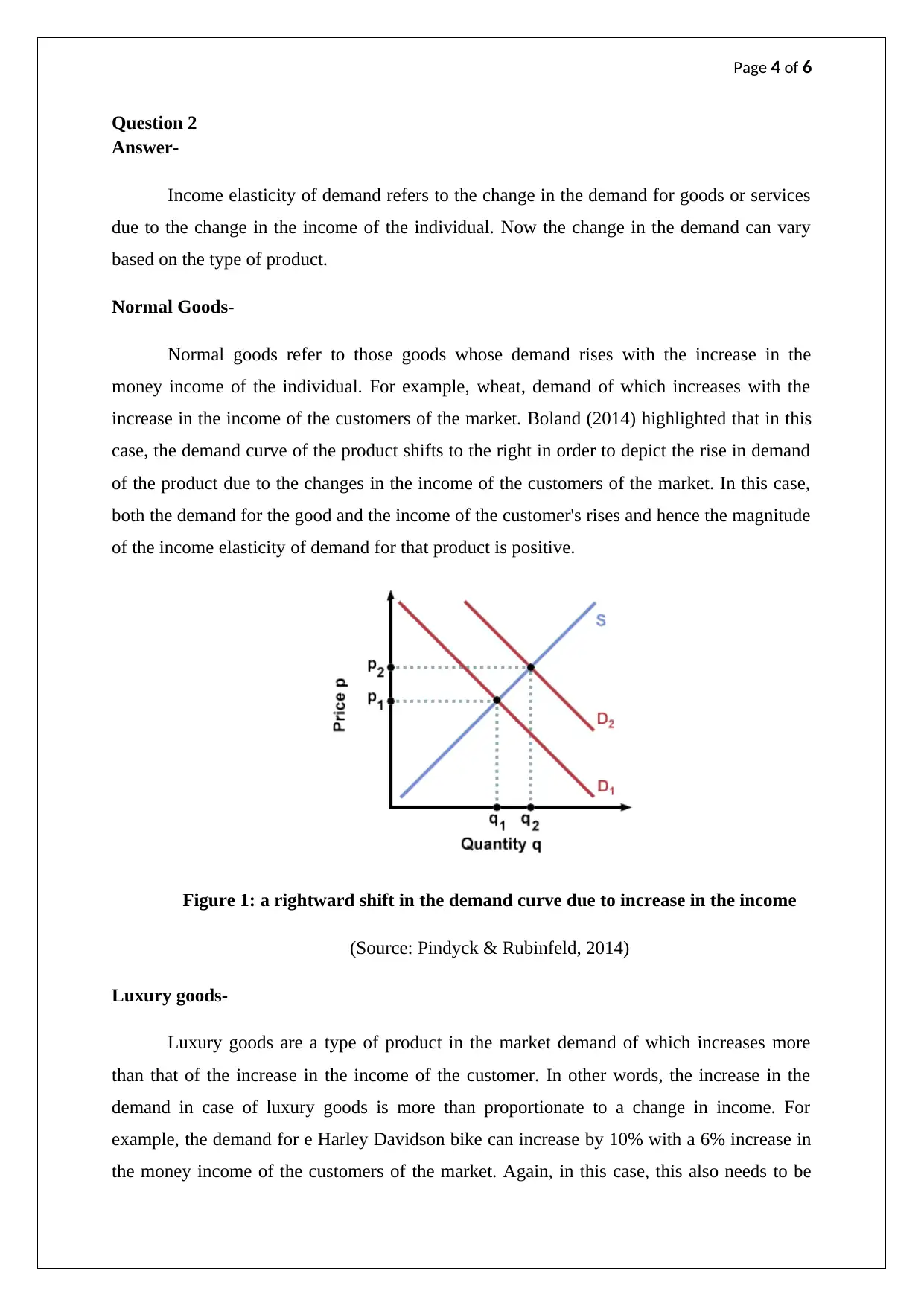
Page 4 of 6
Question 2
Answer-
Income elasticity of demand refers to the change in the demand for goods or services
due to the change in the income of the individual. Now the change in the demand can vary
based on the type of product.
Normal Goods-
Normal goods refer to those goods whose demand rises with the increase in the
money income of the individual. For example, wheat, demand of which increases with the
increase in the income of the customers of the market. Boland (2014) highlighted that in this
case, the demand curve of the product shifts to the right in order to depict the rise in demand
of the product due to the changes in the income of the customers of the market. In this case,
both the demand for the good and the income of the customer's rises and hence the magnitude
of the income elasticity of demand for that product is positive.
Figure 1: a rightward shift in the demand curve due to increase in the income
(Source: Pindyck & Rubinfeld, 2014)
Luxury goods-
Luxury goods are a type of product in the market demand of which increases more
than that of the increase in the income of the customer. In other words, the increase in the
demand in case of luxury goods is more than proportionate to a change in income. For
example, the demand for e Harley Davidson bike can increase by 10% with a 6% increase in
the money income of the customers of the market. Again, in this case, this also needs to be
Question 2
Answer-
Income elasticity of demand refers to the change in the demand for goods or services
due to the change in the income of the individual. Now the change in the demand can vary
based on the type of product.
Normal Goods-
Normal goods refer to those goods whose demand rises with the increase in the
money income of the individual. For example, wheat, demand of which increases with the
increase in the income of the customers of the market. Boland (2014) highlighted that in this
case, the demand curve of the product shifts to the right in order to depict the rise in demand
of the product due to the changes in the income of the customers of the market. In this case,
both the demand for the good and the income of the customer's rises and hence the magnitude
of the income elasticity of demand for that product is positive.
Figure 1: a rightward shift in the demand curve due to increase in the income
(Source: Pindyck & Rubinfeld, 2014)
Luxury goods-
Luxury goods are a type of product in the market demand of which increases more
than that of the increase in the income of the customer. In other words, the increase in the
demand in case of luxury goods is more than proportionate to a change in income. For
example, the demand for e Harley Davidson bike can increase by 10% with a 6% increase in
the money income of the customers of the market. Again, in this case, this also needs to be
Paraphrase This Document
Need a fresh take? Get an instant paraphrase of this document with our AI Paraphraser
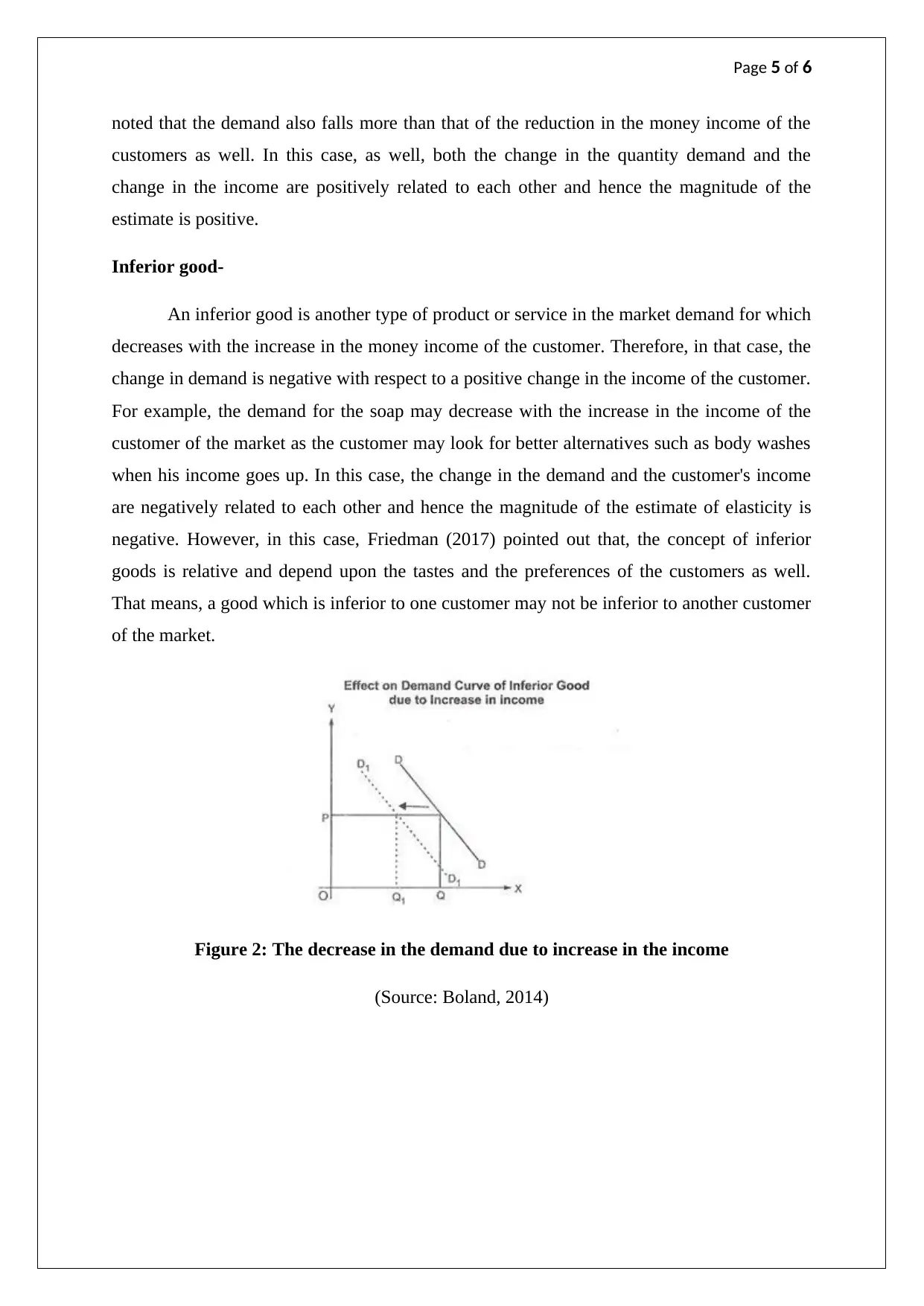
Page 5 of 6
noted that the demand also falls more than that of the reduction in the money income of the
customers as well. In this case, as well, both the change in the quantity demand and the
change in the income are positively related to each other and hence the magnitude of the
estimate is positive.
Inferior good-
An inferior good is another type of product or service in the market demand for which
decreases with the increase in the money income of the customer. Therefore, in that case, the
change in demand is negative with respect to a positive change in the income of the customer.
For example, the demand for the soap may decrease with the increase in the income of the
customer of the market as the customer may look for better alternatives such as body washes
when his income goes up. In this case, the change in the demand and the customer's income
are negatively related to each other and hence the magnitude of the estimate of elasticity is
negative. However, in this case, Friedman (2017) pointed out that, the concept of inferior
goods is relative and depend upon the tastes and the preferences of the customers as well.
That means, a good which is inferior to one customer may not be inferior to another customer
of the market.
Figure 2: The decrease in the demand due to increase in the income
(Source: Boland, 2014)
noted that the demand also falls more than that of the reduction in the money income of the
customers as well. In this case, as well, both the change in the quantity demand and the
change in the income are positively related to each other and hence the magnitude of the
estimate is positive.
Inferior good-
An inferior good is another type of product or service in the market demand for which
decreases with the increase in the money income of the customer. Therefore, in that case, the
change in demand is negative with respect to a positive change in the income of the customer.
For example, the demand for the soap may decrease with the increase in the income of the
customer of the market as the customer may look for better alternatives such as body washes
when his income goes up. In this case, the change in the demand and the customer's income
are negatively related to each other and hence the magnitude of the estimate of elasticity is
negative. However, in this case, Friedman (2017) pointed out that, the concept of inferior
goods is relative and depend upon the tastes and the preferences of the customers as well.
That means, a good which is inferior to one customer may not be inferior to another customer
of the market.
Figure 2: The decrease in the demand due to increase in the income
(Source: Boland, 2014)
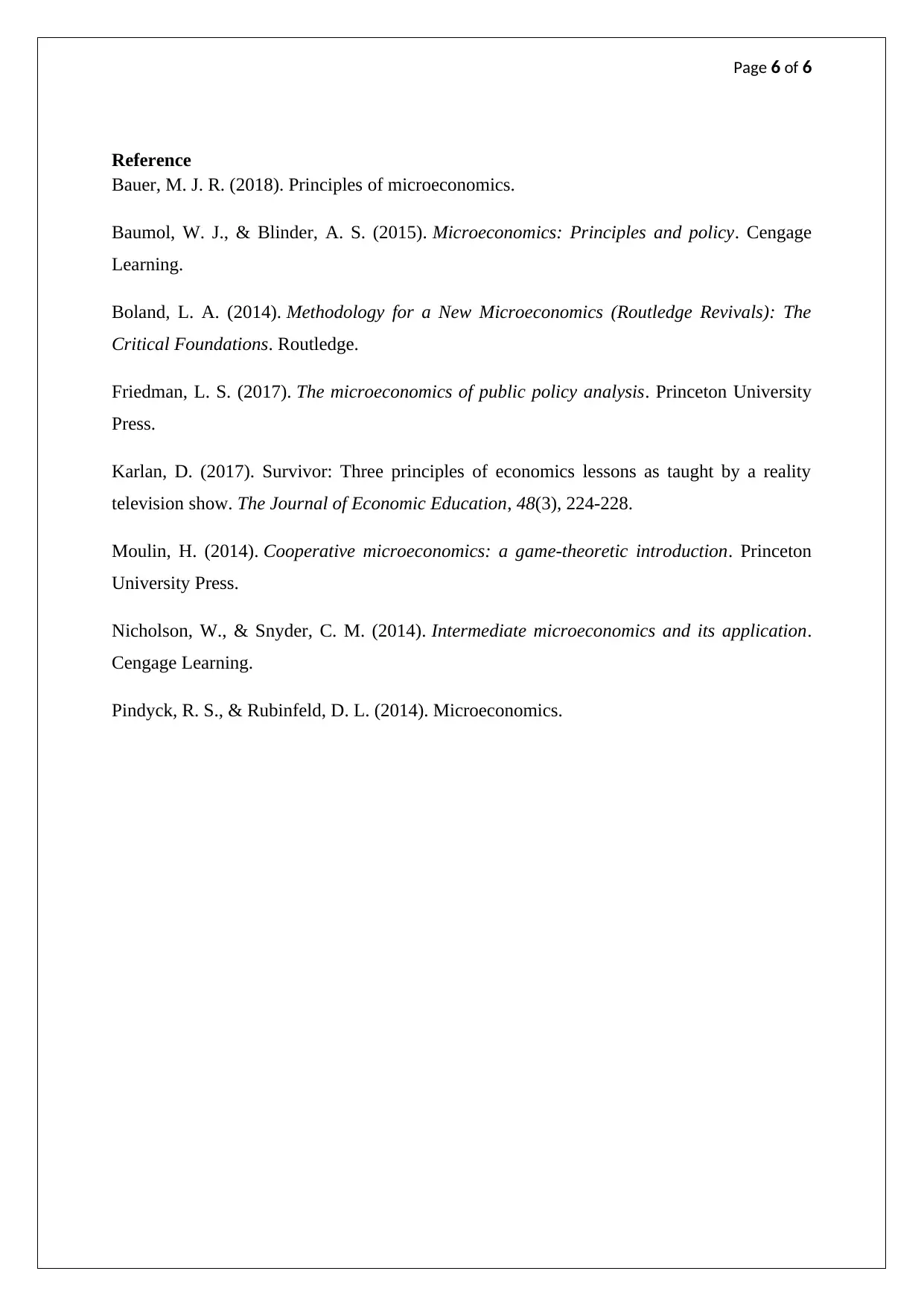
Page 6 of 6
Reference
Bauer, M. J. R. (2018). Principles of microeconomics.
Baumol, W. J., & Blinder, A. S. (2015). Microeconomics: Principles and policy. Cengage
Learning.
Boland, L. A. (2014). Methodology for a New Microeconomics (Routledge Revivals): The
Critical Foundations. Routledge.
Friedman, L. S. (2017). The microeconomics of public policy analysis. Princeton University
Press.
Karlan, D. (2017). Survivor: Three principles of economics lessons as taught by a reality
television show. The Journal of Economic Education, 48(3), 224-228.
Moulin, H. (2014). Cooperative microeconomics: a game-theoretic introduction. Princeton
University Press.
Nicholson, W., & Snyder, C. M. (2014). Intermediate microeconomics and its application.
Cengage Learning.
Pindyck, R. S., & Rubinfeld, D. L. (2014). Microeconomics.
Reference
Bauer, M. J. R. (2018). Principles of microeconomics.
Baumol, W. J., & Blinder, A. S. (2015). Microeconomics: Principles and policy. Cengage
Learning.
Boland, L. A. (2014). Methodology for a New Microeconomics (Routledge Revivals): The
Critical Foundations. Routledge.
Friedman, L. S. (2017). The microeconomics of public policy analysis. Princeton University
Press.
Karlan, D. (2017). Survivor: Three principles of economics lessons as taught by a reality
television show. The Journal of Economic Education, 48(3), 224-228.
Moulin, H. (2014). Cooperative microeconomics: a game-theoretic introduction. Princeton
University Press.
Nicholson, W., & Snyder, C. M. (2014). Intermediate microeconomics and its application.
Cengage Learning.
Pindyck, R. S., & Rubinfeld, D. L. (2014). Microeconomics.
⊘ This is a preview!⊘
Do you want full access?
Subscribe today to unlock all pages.

Trusted by 1+ million students worldwide
1 out of 6
Related Documents
Your All-in-One AI-Powered Toolkit for Academic Success.
+13062052269
info@desklib.com
Available 24*7 on WhatsApp / Email
![[object Object]](/_next/static/media/star-bottom.7253800d.svg)
Unlock your academic potential
Copyright © 2020–2025 A2Z Services. All Rights Reserved. Developed and managed by ZUCOL.




